Delta Electronics F5D72304 Wireless G Router User Manual P74688 F5D7230 4 1223 indd
Delta Networks, Inc. Wireless G Router P74688 F5D7230 4 1223 indd
Contents
Users Manual 3
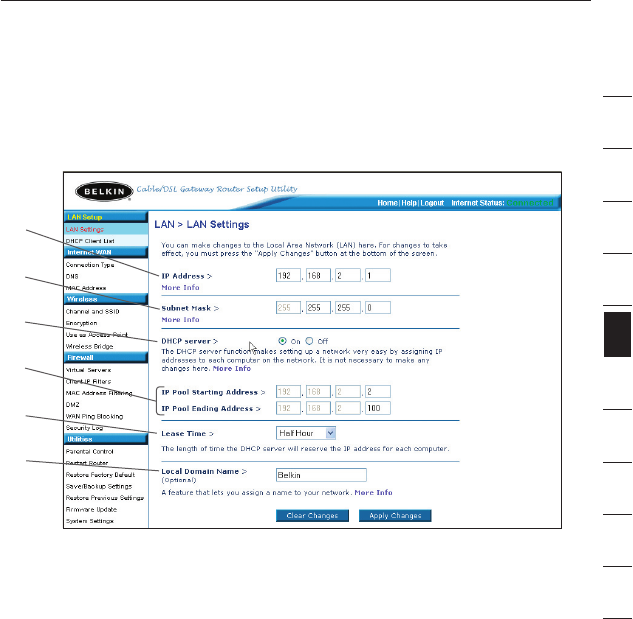
41
Using the Web-Based Advanced User Interface
41
section
2
1
3
4
5
6
7
8
9
10
11
Changing LAN Settings
All settings for the internal LAN setup of the Router can be viewed
and changed here.
1. IP Address
The “IP address” is the internal IP address of the Router. The
default IP address is “192.168.2.1”. To access the advanced
setup interface, type this IP address into the address bar of your
browser. This address can be changed if needed. To change the
IP address, type in the new IP address and click “Apply Changes”.
The IP address you choose should be a non-routable IP.
Examples of a non-routable IP are:
192.168.x.x (where x is anything between 0 and 255)
10.x.x.x (where x is anything between 0 and 255)
2. Subnet Mask
There is no need to change the subnet mask. This is a unique,
advanced feature of your Belkin Router. It is possible to change
the subnet mask if necessary, however, do NOT make changes to
the subnet mask unless you have a specific reason to do so. The
default setting is “255.255.255.0”.
(1)
(2)
(3)
(4)
(6)
(5)

4342
Using the Web-Based Advanced User Interface
4342
Using the Web-Based Advanced User Interface
3. DHCP Server
The DHCP server function makes setting up a network very easy
by assigning IP addresses to each computer on the network
automatically. The default setting is “On”. The DHCP server
can be turned OFF if necessary, however, in order to do so you
must manually set a static IP address for each computer on
your network. To turn off the DHCP server, select “Off” and click
“Apply Changes”.
4. IP Pool
The range of IP addresses set aside for dynamic assignment to the
computers on your network. The default is 2–100 (99 computers). If
you want to change this number, you can do so by entering a new
starting and ending IP address and clicking on “Apply Changes”.
The DHCP server can assign 100 IP addresses automatically. This
means that you cannot specify an IP address pool larger than 100
computers. For example, starting at 50 means you have to end at
150 or lower so as not to exceed the 100-client limit. The starting
IP address must be lower in number than the ending IP address.
5. Lease Time
The length of time the DHCP server will reserve the IP address
for each computer. We recommend that you leave the lease
time set to “Forever”. The default setting is “Forever”, meaning
that any time a computer is assigned an IP address by the
DHCP server, the IP address will not change for that particular
computer. Setting lease times for shorter intervals such as one
day or one hour frees IP addresses after the specified period of
time. This also means that a particular computer’s IP address
may change over time. If you have set any of the other advanced
features of the Router such as DMZ or client IP filters, these are
dependent on the IP address. For this reason, you will not want
the IP address to change.
6. Local Domain Name
The default setting is “Belkin”. You can set a local domain name
(network name) for your network. There is no need to change this
setting unless you have a specific advanced need to do so. You can
name the network anything you want such as “MY NETWORK”.
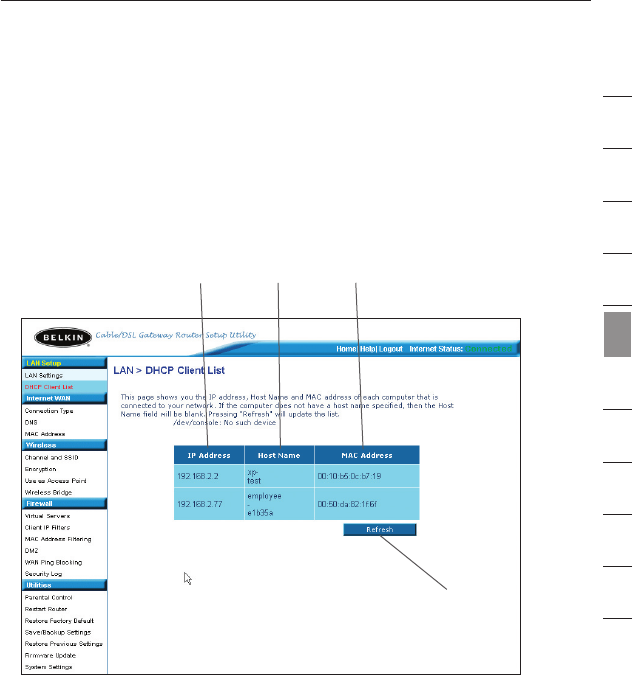
43
Using the Web-Based Advanced User Interface
43
section
2
1
3
4
5
6
7
8
9
10
11
Viewing the DHCP Client List Page
You can view a list of the computers (known as clients), which are
connected to your network. You are able to view the IP address (1) of
the computer, the host name (2) (if the computer has been assigned
one), and the MAC address (3) of the computer’s network interface
card (NIC). Pressing the “Refresh” (4) button will update the list. If
there have been any changes, the list will be updated.
(1) (2) (3)
(4)
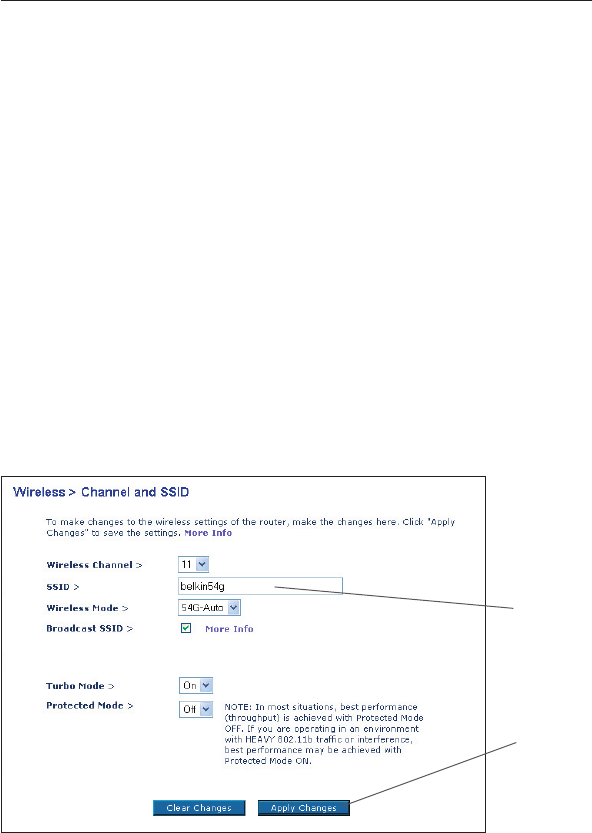
4544
Using the Web-Based Advanced User Interface
4544
Using the Web-Based Advanced User Interface
Configuring the Wireless Network Settings
The Wireless tab lets you make changes to the wireless network
settings. From this tab you can make changes to the wireless network
name (SSID), operating channel, encryption security settings, and
configure the Router to be used as an access point.
Changing the Wireless Network Name (SSID)
To identify your wireless network, a name called the SSID (Service
Set Identifier) is used. The default SSID of the Router is “belkin54g”.
You can change this to anything you want to or you can leave it
unchanged. If there are other wireless networks operating in your
area, you will want to make sure that your SSID is unique (does not
match that of another wireless network in the area). To change the
SSID, type in the SSID that you want to use in the SSID field (1) and
click “Apply Changes” (2). The change is immediate. If you make a
change to the SSID, your wireless-equipped computers may also need
to be reconfigured to connect to your new network name. Refer to the
documentation of your wireless network adapter for information on
making this change.
(1)
(2)

45
Using the Web-Based Advanced User Interface
45
section
2
1
3
4
5
6
7
8
9
10
11
Using the Wireless Mode Switch
Your Router can operate in three different wireless modes: “802.11g-
Auto”, “802.11g-Only”, and “802.11g-LRS”. The different modes are
explained below.
802.11g-Auto Mode
In this mode, the Router is compatible with 802.11b and 802.11g
wireless clients simultaneously. This is the factory default mode and
ensures successful operation with all Wi-Fi-compatible devices. If
you have a mix of 802.11b and 802.11g clients in your network, we
recommend setting the Router to 802.11g-Auto mode. This setting
should only be changed if you have a specific reason to do so.
802.11g-Only Mode
802.11g-Only mode works with 802.11g clients only. This mode
is recommended only if you want to prevent 802.11b clients from
accessing your network. To switch modes, select the desired
mode from the “Wireless Mode” drop-down box. Then, click
“Apply Changes”.
802.11g-LRS Mode
We recommend you DO NOT use this mode unless you have a very
specific reason to do so. This mode exists only to solve unique
problems that may occur with some 802.11b client adapters and is
NOT necessary for interoperability of 802.11g and 802.11b standards.
When to Use 802.11g-LRS Mode
In some cases, older 802.11b clients may not be compatible with
802.11g wireless. These adapters tend to be of inferior design and
may use older drivers or technology. 802.11g-LRS (Limited Rate
Support) allows these clients to be compatible with the newer
802.11g technology. Switching to this mode can solve problems that
sometimes occur with these clients. If you suspect that you are using
a client adapter that falls into this category of adapters, first check
with the adapter vendor to see if there is a driver update. If there
is no driver update available, switching to 802.11g-LRS mode may
fix your problem. Please note that switching to 802.11g-LRS mode may
decrease 802.11g performance slightly.
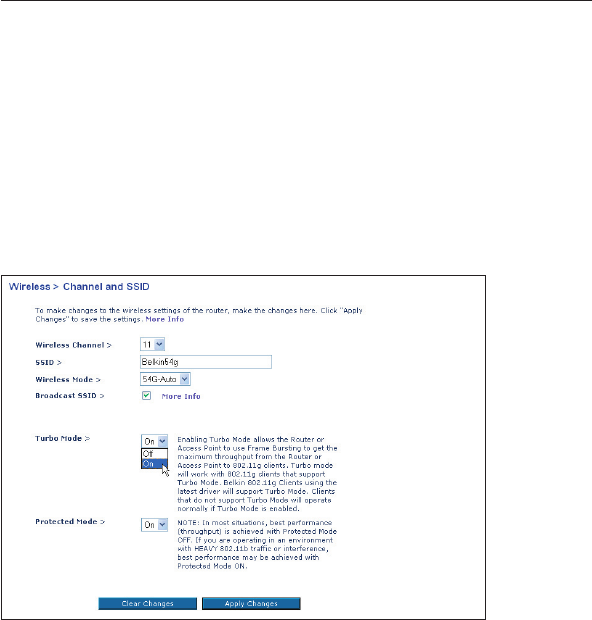
4746
Using the Web-Based Advanced User Interface
4746
Using the Web-Based Advanced User Interface
Using Turbo Mode
Selecting “On” will result in all devices capable of turbo mode to
function in turbo mode, and all clients not capable, to operate in
normal 802.11g modes. Turbo mode supports both Turbo-enabled
devices and non-Turbo-enabled devices simultaneously. Turbo mode
is based on the unreleased 802.11e specification.
Selecting “Off” will disable Turbo mode.
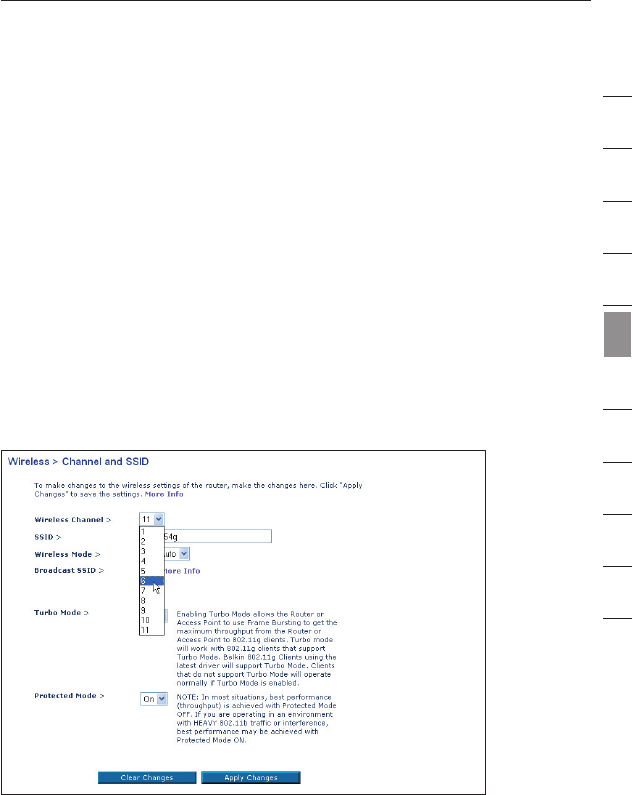
47
Using the Web-Based Advanced User Interface
47
section
2
1
3
4
5
6
7
8
9
10
11
Changing the Wireless Channel
There are a number of operating channels you can choose from. In
the United States and Australia, there are 11 channels. In the United
Kingdom and most of Europe, there are 13 channels. In a small
number of other countries, there are other channel requirements.
Your Router is configured to operate on the proper channels for
the country you reside in. The default channel is 11 (unless you are
in a country that does not allow channel 11). The channel can be
changed if needed. If there are other wireless networks operating in
your area, your network should be set to operate on a channel that is
different than the other wireless networks. For best performance, use
a channel that is at least five channels away from the other wireless
network. For instance, if another network is operating on channel 11,
then set your network to channel 6 or below. To change the channel,
select the channel from the drop-down list. Click “Apply Changes”.
The change is immediate.

4948
Using the Web-Based Advanced User Interface
4948
Using the Web-Based Advanced User Interface
Using the Broadcast SSID Feature
Note: This advanced feature should be employed by advanced users only.
For security, you can choose not to broadcast your network’s SSID.
Doing so will keep your network name hidden from computers that
are scanning for the presence of wireless networks. To turn off the
broadcast of the SSID, remove the check mark from the box next to
“Broadcast SSID”, and then click “Apply Changes”. The change is
immediate. Each computer now needs to be set to connect to your
specific SSID; an SSID of “ANY” will no longer be accepted. Refer to
the documentation of your wireless network adapter for information
on making this change.
Protected Mode Switch
As part of the 802.11g specification, Protected Mode ensures proper
operation of 802.11g clients and access points when there is heavy
802.11b traffic in the operating environment. When Protected mode
is ON, 802.11g scans for other wireless network traffic before it
transmits data. Therefore, using this mode in environments with
HEAVY 802.11b traffic or interference achieves best performance
results. If you are in an environment with very little—or no—other
wireless network traffic, your best performance will be achieved with
Protected mode OFF.

49
Using the Web-Based Advanced User Interface
49
section
2
1
3
4
5
6
7
8
9
10
11
Securing your Wi-Fi® Network
Here are a few different ways you can maximize the security of
your wireless network and protect your data from prying eyes and
ears. This section is intended for the home, home office, and small
office user. At the time of this manual’s publication, there are three
encryption methods available.
Name 64-bit Wired
Equivalent
Privacy
128-bit Wired
Equivalent
Privacy
Wi-Fi Protected
Access-TKIP
With Protected
Access
Acronym 64-bit WEP 128-bit WEP WPA-TKIP WPA-AES
Security Good Better Best Best
Features Static keys Static keys Dynamic key
encryption
and mutual
authentication.
Dynamic key
encryption
and mutual
authentication.
Encryption
keys based
on RC4
algorithm
(typically
40-bit keys)
More secure
than 64-bit
WEP using a
key length of
104 bits plus
24 additional
bits of system
generated
data.
TKIP (temporal
key integrity
protocol)
added so
that keys are
rotated and
encryption is
strengthened.
AES (Advanced
Encryption
Standard) does
not cause any
throughput
loss.
WEP (Wired Equivalent Privacy)
WEP (Wired Equivalent Privacy) is a common protocol that adds
security to all Wi-Fi-compliant wireless products. WEP was designed
to give wireless networks the equivalent level of privacy protection as
a comparable wired network.
64-Bit WEP
64-bit WEP was first introduced with 64-bit encryption, which
includes a key length of 40 bits plus 24 additional bits of
system-generated data (64 bits total). Some hardware manufacturers
refer to 64-bit as 40-bit encryption. Shortly after the technology was
introduced, researchers found that 64-bit encryption was too easy
to decode.

5150
Using the Web-Based Advanced User Interface
5150
Using the Web-Based Advanced User Interface
128-Bit WEP
As a result of 64-bit WEP’s potential security weaknesses, a more
secure method of 128-bit encryption was developed. 128-bit
encryption includes a key length of 104 bits plus 24 additional bits of
system-generated data (128 bits total). Some hardware manufacturers
refer to 128-bit as 104-bit encryption.
Most of the new wireless equipment in the market today supports
both 64-bit and 128-bit WEP encryption, but you might have older
equipment that only supports 64-bit WEP. All Belkin wireless products
will support both 64-bit and 128-bit WEP.
Encryption Keys
After selecting either the 64-bit or 128-bit WEP encryption mode, it is
critical that you generate an encryption key. If the encryption key is
not consistent throughout the entire wireless network, your wireless
networking devices will be unable to communicate with one another
on your network and you will not be able to successfully communicate
within your network.
You can enter your key by typing in the hex key manually, or you can
type in a passphrase in the “Passphrase” field and click “Generate”
to create a key. A hex (hexadecimal) key is a mixture of numbers and
letters from A–F and 0–9. For 64-bit WEP, you need to enter 10 hex
keys. For 128-bit WEP, you need to enter 26 hex keys.
For instance:
AF 0F 4B C3 D4 = 64-bit WEP key
C3 03 0F AF 0F 4B B2 C3 D4 4B C3 D4 E7 = 128-bit WEP key
The WEP passphrase is NOT the same as a WEP key. Your card uses
this passphrase to generate your WEP keys, but different hardware
manufacturers might have different methods on generating the keys.
If you have multiple vendors’ equipments in your network, the easiest
thing to do is to use the hex WEP key from your Router or access
point and enter it manually into the hex WEP key table in your card’s
configuration screen.

51
Using the Web-Based Advanced User Interface
51
section
2
1
3
4
5
6
7
8
9
10
11
WPA (Wi-Fi Protected Access)
WPA (Wi-Fi Protected Access) is a new Wi-Fi standard that was
designed to improve upon the security features of WEP. To use WPA
security, the drivers and software of your wireless equipment must
be upgraded to support WPA. These updates will be found on the
wireless vendors website. There are two types of WPA security, WPA-
PSK (no server) and WPA (with radius server).
WPA-PSK (no server) uses what is known as a
Pre-Shared key as the Network key. A Network key is basically a
password that is between 8 and 63 characters long. It can be a
combination of letters, numbers, or characters. Each client uses the
same Network key to access the network. Typically, this is the mode
that will be used in a home environment.
WPA (with radius server) is a system where a radius server
distributes the Network key to the clients automatically. This is
typically found in a business environment.
For a list of Belkin wireless products that support WPA, please visit
our website at www.belkin.com/networking.
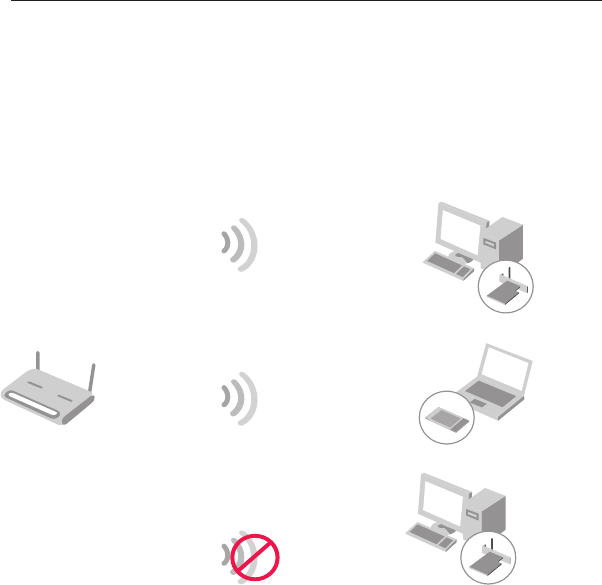
5352
Using the Web-Based Advanced User Interface
5352
Using the Web-Based Advanced User Interface
Sharing the Same Network Keys
Most Wi-Fi products ship with security turned off. So once you have
your network working, you need to activate WEP or WPA and make
sure your wireless networking devices are sharing the same
Network key.
The Wireless G Desktop Network Card cannot access the network
because it is using a different Network key than the Network key that
is configured on the Wireless G Router.
Network key=
WRONG Password
Network key=
MyPassword
Network key=
MyPassword
Network key=
MyPassword

53
Using the Web-Based Advanced User Interface
53
section
2
1
3
4
5
6
7
8
9
10
11
Using a Hexadecimal Key
A hexadecimal key is a mixture of numbers and letters from A–F and
0–9. 64-bit keys are five two-digit numbers. 128-bit keys are 13
two-digit numbers.
For instance:
AF 0F 4B C3 D4 = 64-bit key
C3 03 0F AF 0F 4B B2 C3 D4 4B C3 D4 E7 = 128-bit key
In the boxes below, make up your key by writing in two characters
between A–F and 0–9 in each box. You will use this key to program
the encryption settings on your Router and your wireless computers.
Note to Mac users: Original Apple AirPort® products support 64-
bit encryption only. Apple AirPort 2 products can support 64-bit or
128-bit encryption. Please check your product to see which version
you are using. If you cannot configure your network with 128-bit
encryption, try 64-bit encryption.
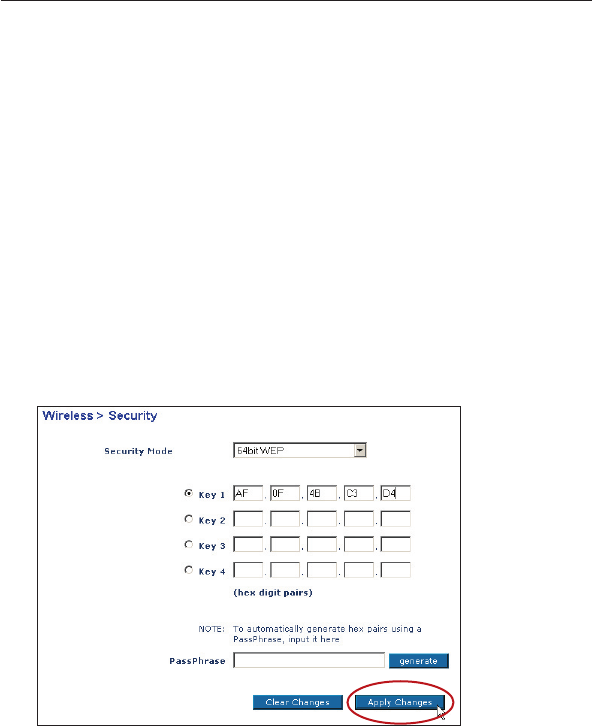
5554
Using the Web-Based Advanced User Interface
5554
Using the Web-Based Advanced User Interface
WEP Setup
64-Bit WEP Encryption
1 Select “64-bit WEP” from the drop-down menu.
2. After selecting your WEP encryption mode, you can enter your
key by typing in the hex key manually, or you can type in a
passphrase in the “Passphrase” field and click “Generate” to
create a key.
A hex (hexadecimal) key is a mixture of numbers and letters from
A–F and 0–9. For 64-bit WEP, you need to enter 10 hex keys.
For instance:
AF 0F 4B C3 D4 = 64-bit WEP key
3. Click “Apply Changes” to finish. Encryption in the Router is now
set. Each of your computers on your wireless network will now
need to be configured with the same security settings.
WARNING: If you are configuring the Wireless Router or Access Point
from a computer with a wireless client, you will need to ensure that
security is turned ON for this wireless client. If this is not done, you
will lose your wireless connection.
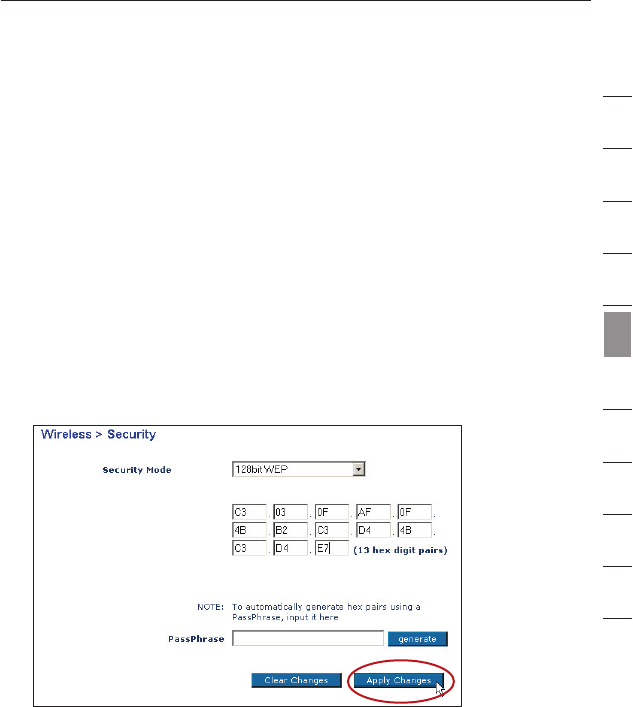
55
Using the Web-Based Advanced User Interface
55
section
2
1
3
4
5
6
7
8
9
10
11
128-Bit WEP Encryption
Note to Mac® users: The Passphrase option will not operate with
Apple® AirPort®. To configure encryption for your Mac computer,
set the encryption using the manual method described in the
next section.
1. Select “128-bit WEP” from the drop-down menu.
2. After selecting your WEP encryption mode, you can enter your
key manually by typing in the hex key manually, or you can type
in a passphrase in the “Passphrase” field and click “Generate” to
create a key.
A hex (hexadecimal) key is a mixture of numbers and letters from
A–F and 0–9. For 128-bit WEP, you need to enter 26 hex keys.
For instance:
C3 03 0F AF 0F 4B B2 C3 D4 4B C3 D4 E7 = 128-bit WEP key
3. Click “Apply Changes” to finish. Encryption in the Router is now
set. Each of your computers on your wireless network will now
need to be configured with the same security settings.
WARNING: If you are configuring the Wireless Router or Access Point
from a computer with a wireless client, you will need to ensure that
security is turned on for this wireless client. If this is not done, you
will lose your wireless connection.

5756
Using the Web-Based Advanced User Interface
5756
Using the Web-Based Advanced User Interface
Changing the Wireless Security Settings
Your Router is equipped with WPA (Wireless Protected Access), the
latest wireless security standard. It also supports the legacy security
standard, WEP (Wired Equivalent Privacy). By default, wireless
security is disabled. To enable security, you must first determine
which standard you want to use. To access the security settings, click
“Security” on the Wireless tab.
WPA Setup
Note: To use WPA security, all your clients must be upgraded to
drivers and software that support it. At the time of this manual’s
publication, a security patch download is available, for free, from
Microsoft. This patch works only with the Windows XP operating
system. You also need to download the latest driver for your Belkin
Wireless G Desktop or Notebook Network Card from the Belkin
support site. Other operating systems are not supported at this time.
Microsoft’s patch only supports devices with WPA-enabled drivers
such as Belkin 802.11g products.
There are two types of WPA security: WPA-PSK (no server) and WPA
(with radius server). WPA-PSK (no server) uses a so-called Pre-
Shared key as the security key. A Pre-Shared key is a password that
is between 8 and 63 characters long. It can be a combination of
letters, numbers, and other characters. Each client uses the same key
to access the network. Typically, this mode will be used in a home
environment.
WPA (with radius server) is a configuration wherein a radius server
distributes the keys to the clients automatically. This is typically used
in a business environment.
Setting WPA-PSK (no server)
1. From the “Security Mode” drop-down menu, select “WPA-PSK
(no server)”.
2. For Encryption Technique, select “TKIP” or “AES”. This setting
will have to be identical on the clients that you set up.
3. Enter your pre-shared key. This can be from 8 to 63 characters
and can be letters, numbers, or symbols. This same key must be
used on all of the clients that you set up. For example, your PSK
might be something like: “Smith family network key”.
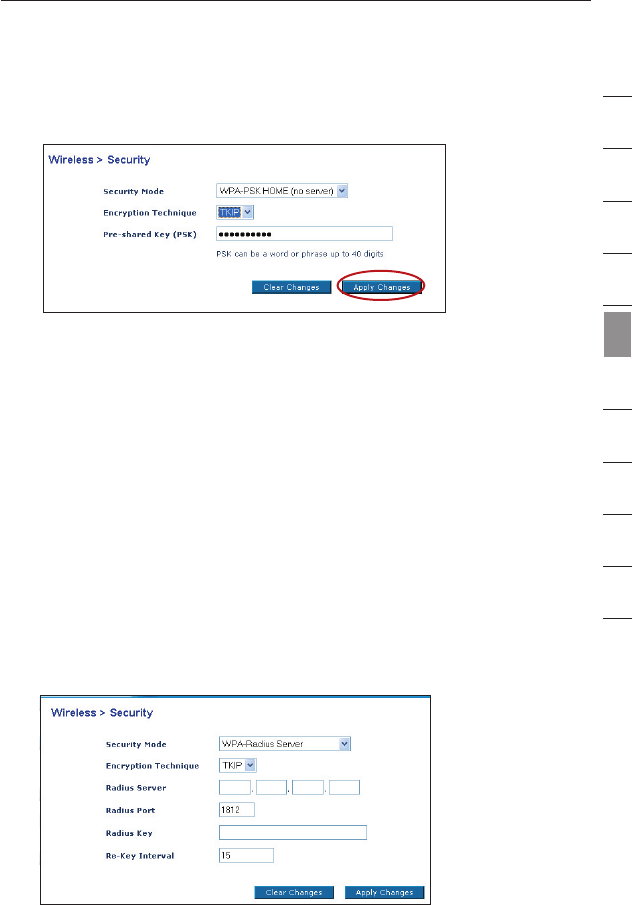
57
Using the Web-Based Advanced User Interface
57
section
2
1
3
4
5
6
7
8
9
10
11
4. Click “Apply Changes” to finish. You must now set all clients to
match these settings.
Setting WPA (with radius server) Settings
If your network uses a radius server to distribute keys to the clients,
use this setting.
1. From the “Security Mode” drop-down menu, select
“WPA—Radius Server”.
2. For Encryption Technique, select “TKIP” or “AES”. This setting
will have to be identical on the clients that you set up.
3. Enter the IP address of the radius server into the “Radius
Server” fields.
4. Enter the radius key into the “Radius Key” field.
5. Enter the key interval. Key interval is how often the keys are
distributed (in packets).
6. Click “Apply Changes” to finish. You must now set all clients to
match these settings.
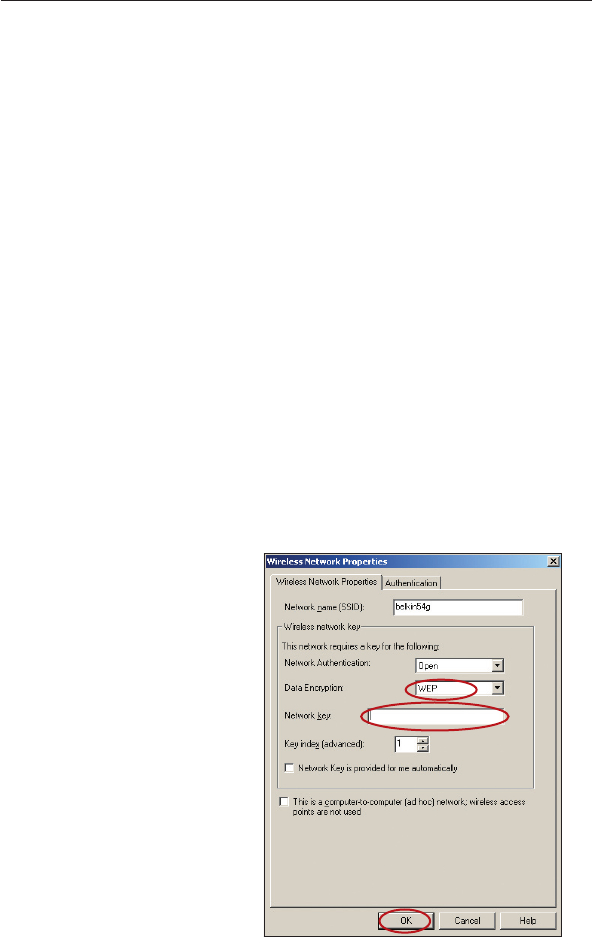
5958
Using the Web-Based Advanced User Interface
5958
Using the Web-Based Advanced User Interface
Configuring your Belkin Wireless G Network Cards to
Use Security
Please Note: This section is to provide you with the information on how
to configure your Belkin Wireless G Network Cards to use security.
At this point, you should already have your Wireless Router or Access
Point set to use WPA or WEP. In order for you to gain a wireless
connection, you will need to set your wireless notebook card and
wireless desktop card to use the same security settings.
Connecting your Computer to a Wireless Network that Requires a
64-bit or 128-bit WEP key:
1. Double-click the Signal Indicator icon to bring up the Wireless
Network screen. The Advanced button will allow you to view and
configure more options of your card.
2. Under the “Wireless Network Properties” tab, select a network
name from the “Available networks” list and click “Configure”.
3. Under “Data Encryption” select “WEP”.
4. Ensure the check box “Network key is provided for me
automatically” at the bottom is unchecked. If you are using this
computer to connect to a corporate network, please consult your
network administrator if this box needs to be checked.
5. Type your WEP key in
the “Network key” box.
Important: A WEP key is
a mixture of numbers and
letters from A–F and 0–9.
For 128-bit WEP, you need
to enter 26 keys. For
64-bit WEP, you need to
enter 10 keys. This Network
key needs to match the key
you assign to your Wireless
Router or Access Point.
6. Click “OK” to save
the settings.
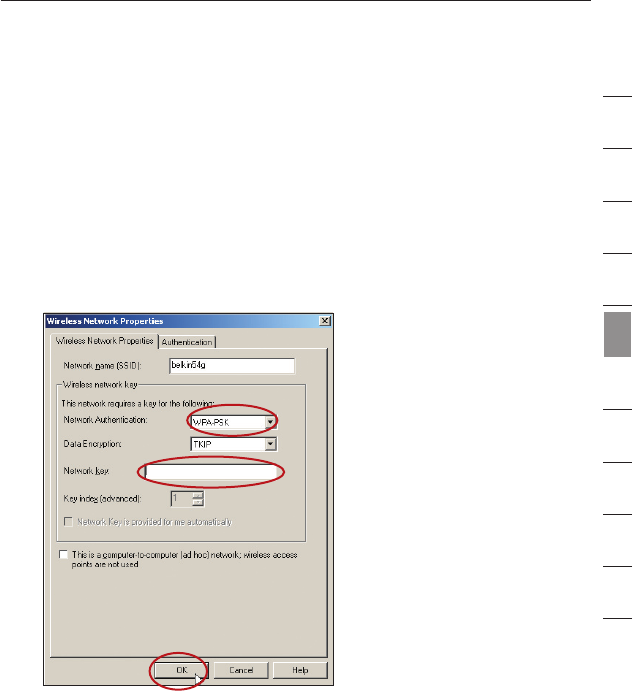
59
Using the Web-Based Advanced User Interface
59
section
2
1
3
4
5
6
7
8
9
10
11
Connecting your Computer to a Wireless Network that Requires
WPA-PSK (no server)
1. Double-click the “Signal Indicator” icon to bring up the “Wireless
Network” screen. The Advanced button will allow you to view and
configure more options of your card.
2. Under the “Wireless Networks” tab, select a network name from
the “Available networks” list and click “Configure”.
3. Under “Network Authentication” select “WPA-PSK (No Server)”.
4. Type your WPA key in the “Network key” box.
Important: WPA-PSK is a mixture of numbers and letters from
A–Z and 0–9. For WPA-PSK you can enter 8 to 63 keys. This
Network key needs to match the key you assign to your Wireless
Router or Access Point.
5. Click “OK” to save the settings.
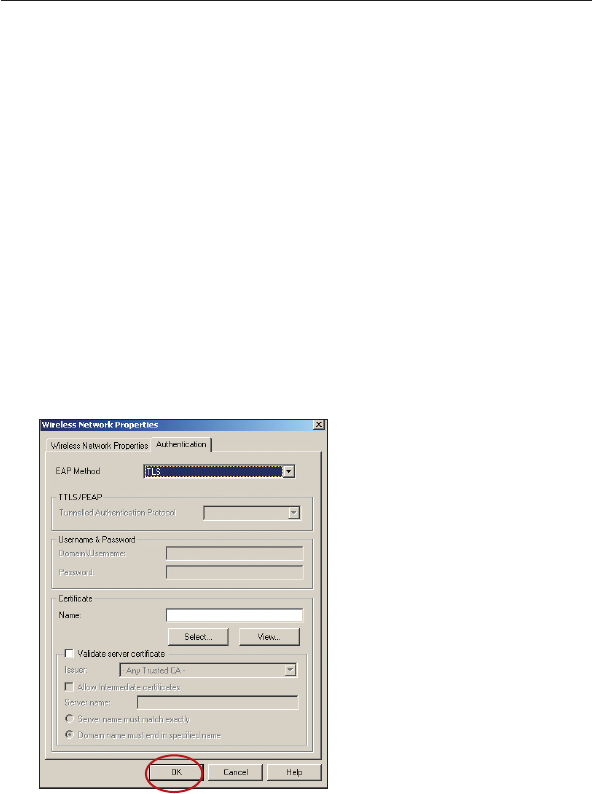
6160
Using the Web-Based Advanced User Interface
6160
Using the Web-Based Advanced User Interface
Connecting your Computer to a Wireless Network that Requires
WPA (with radius server)
1. Double-click the Signal Indicator icon to bring up the “Wireless
Network” screen. The “Advanced” button will allow you to view
and configure more options of your Card.
2. Under the “Wireless Networks” tab, select a network name from
the “Available networks” list and click “Configure”.
3. Under “Network Authentication” select WPA.
4. Under the “Authentication” tab, select the settings that are
indicated by your network administrator.
5. Click “OK” to save the settings.

61
Using the Web-Based Advanced User Interface
61
section
2
1
3
4
5
6
7
8
9
10
11
Setting Up WPA for a Non-Belkin Wireless Desktop and
Wireless Notebook Cards
For non-Belkin WPA Wireless Desktop and Wireless Notebook
Cards that are not equipped with WPA-enabled software, a file from
Microsoft called “Windows XP Support Patch for Wireless Protected
Access” is available for free download.
Please Note: The file that Microsoft has made available works only
with Windows XP. Other operating systems are not supported at
this time.
Important: You also need to ensure that the wireless card
manufacturer supports WPA and that you have downloaded and
installed the latest driver from their support site.
Supported Operating Systems:
• Windows XP Professional
• Windows XP Home Edition
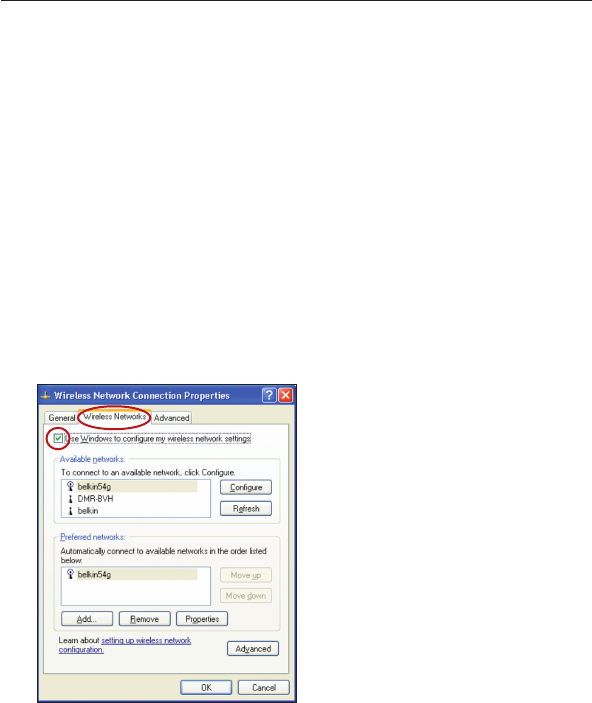
6362
Using the Web-Based Advanced User Interface
6362
Using the Web-Based Advanced User Interface
Setting Up Windows XP Wireless Network Utility to Use
WPA-PSK
In order to use WPA-PSK, ensure you are using Windows Wireless
Network Utility by doing the following:
1. Under Windows XP, click “Start > Control Panel > Network
Connections”.
2. Right-click on “Wireless Network Connection”, and select
“Properties”.
3. Clicking on the “Wireless Networks” tab will display the following
screen. Ensure the “Use Windows to configure my wireless
network settings” check box is checked.
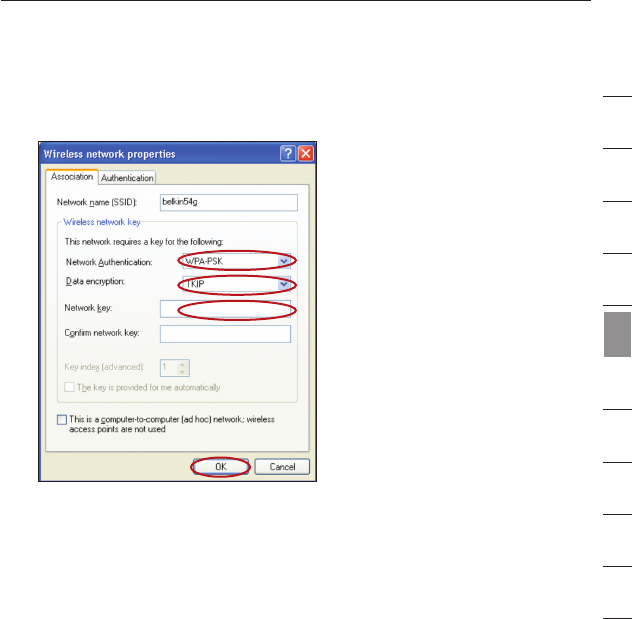
63
Using the Web-Based Advanced User Interface
63
section
2
1
3
4
5
6
7
8
9
10
11
4. Under the Wireless Networks tab, click the “Configure” button,
and you will see the following screen.
5. For a home or small business user, select “WPA-PSK” under
“Network Authentication”.
Note: Select “WPA” if you are using this computer to connect to
a corporate network that supports an authentication server such
as a radius server, please consult your network administrator for
further information.
6. Select “TKIP” or “AES” under “Data Encryption”. This setting will
have to be identical to the Router that you set up.
7. Type in your encryption key in the “Network Key” box.
Important: Enter your Pre-Shared key. This can be from 8 to 63
characters and can be letters, numbers, or symbols. This same key
must be used on all of the clients that you set up.
8. Click “OK” to apply settings.

6564
Using the Web-Based Advanced User Interface
6564
Using the Web-Based Advanced User Interface
Using the Access Point Mode
Note: This advanced feature should be employed by advanced users
only. The Router can be configured to work as a wireless network
access point. Using this mode will defeat the NAT IP sharing feature
and DHCP server. In Access Point (AP) mode, the Router will need to
be configured with an IP address that is in the same subnet as the
rest of the network that you will bridge to. The default IP address
is 192.168.2.254 and subnet mask is 255.255.255.0. These can be
customized for your need.
1. Enable the AP mode my selecting “Enable” in the “Use as Access
Point only” page. When you select this option, you will be able to
change the IP settings.
2. Set your IP settings to match your network. Click “Apply
Changes”.
3. Connect a cable from the WAN port on the Router to your
existing network.
The Router is now acting as an access point. To access the Router’s
advanced user interface again, type the IP address you specified into
your browser’s navigation bar. You can set the encryption settings,
MAC address filtering, SSID, and channel normally.
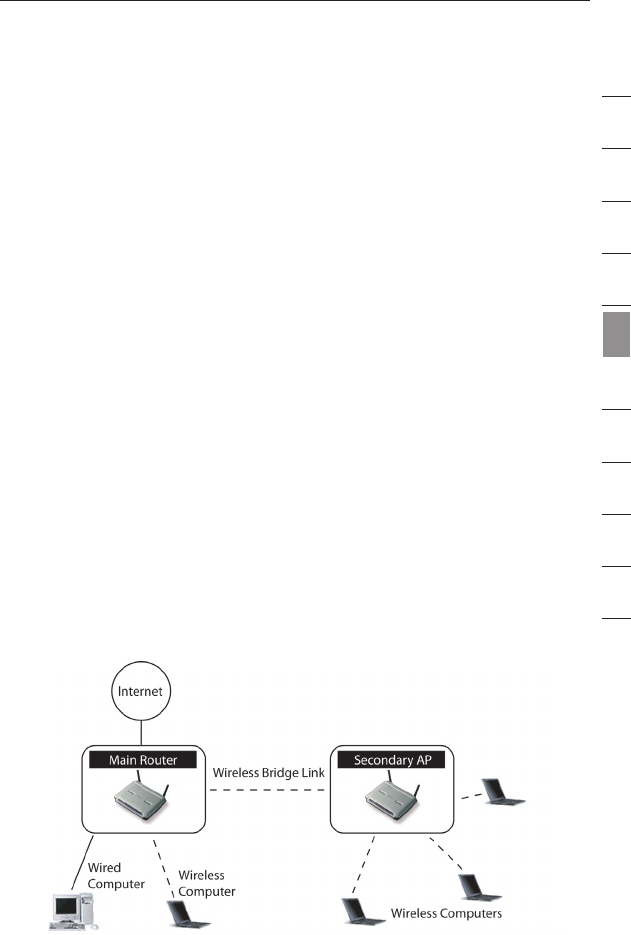
65
Using the Web-Based Advanced User Interface
65
section
2
1
3
4
5
6
7
8
9
10
11
Wireless Range Extension and Bridging
Wireless Range Extension and Bridging works with the following
models only:
F5D7231-4 Wireless G Router with High-Speed Mode*,
F5D7230-4 Wireless Router
F5D7130 Wireless Range Extender/Access Point
Please make sure to download the latest firmware version for the Router or
Access Point for optimal performance: http://web.belkin.com/support
What is a Wireless Bridge?
A wireless bridge is actually a “mode” in which your Wireless Router
can directly connect to a secondary Wireless Access Point. Note that
you can only bridge your Wireless G Router (model F5D7230-4,
F5D7231-4) to a Belkin Wireless G Range Extender/Access Point
(model F5D7131, F5D7130). Bridging with access points of other
manufacturers is not supported at this time. You can use the bridge
mode to extend the range of your wireless network, or add an
extension of your network in another area of your office or home
without running cables.
Range Extension
Range extension will extend the wireless coverage area in your home
or office. The example on the next page illustrates use of bridging to
extend the range of your wireless network. In this example, the Router
is set up to connect to an Access Point located in another area.
Laptops can roam, or move between the two wireless coverage areas.
*Wireless Range Extension and Bridging will not work while in 125 HSM mode